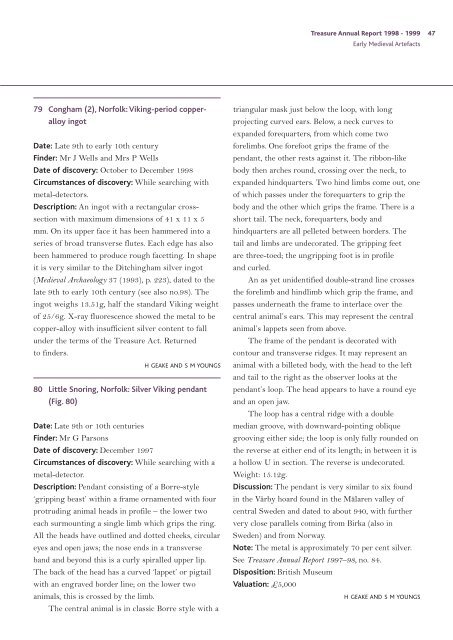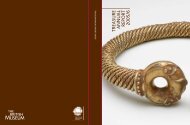Treasure Annual Report 1998-1999 - Portable Antiquities Scheme
Treasure Annual Report 1998-1999 - Portable Antiquities Scheme
Treasure Annual Report 1998-1999 - Portable Antiquities Scheme
You also want an ePaper? Increase the reach of your titles
YUMPU automatically turns print PDFs into web optimized ePapers that Google loves.
79 Congham (2), Norfolk: Viking-period copper-<br />
alloy ingot<br />
Date: Late 9th to early 10th century<br />
Finder: Mr J Wells and Mrs P Wells<br />
Date of discovery: October to December <strong>1998</strong><br />
Circumstances of discovery: While searching with<br />
metal-detectors.<br />
Description: An ingot with a rectangular crosssection<br />
with maximum dimensions of 41 x 11 x 5<br />
mm. On its upper face it has been hammered into a<br />
series of broad transverse flutes. Each edge has also<br />
been hammered to produce rough facetting. In shape<br />
it is very similar to the Ditchingham silver ingot<br />
(Medieval Archaeology 37 (1993), p. 223), dated to the<br />
late 9th to early 10th century (see also no.98). The<br />
ingot weighs 13.51g, half the standard Viking weight<br />
of 25/6g. X-ray fluorescence showed the metal to be<br />
copper-alloy with insufficient silver content to fall<br />
under the terms of the <strong>Treasure</strong> Act. Returned<br />
to finders.<br />
H GEAKE AND S M YOUNGS<br />
80 Little Snoring, Norfolk: Silver Viking pendant<br />
(Fig. 80)<br />
Date: Late 9th or 10th centuries<br />
Finder: Mr G Parsons<br />
Date of discovery: December 1997<br />
Circumstances of discovery: While searching with a<br />
metal-detector.<br />
Description: Pendant consisting of a Borre-style<br />
‘gripping beast’ within a frame ornamented with four<br />
protruding animal heads in profile – the lower two<br />
each surmounting a single limb which grips the ring.<br />
All the heads have outlined and dotted cheeks, circular<br />
eyes and open jaws; the nose ends in a transverse<br />
band and beyond this is a curly spiralled upper lip.<br />
The back of the head has a curved ‘lappet’ or pigtail<br />
with an engraved border line; on the lower two<br />
animals, this is crossed by the limb.<br />
The central animal is in classic Borre style with a<br />
<strong>Treasure</strong> <strong>Annual</strong> <strong>Report</strong> <strong>1998</strong> - <strong>1999</strong> 47<br />
Early Medieval Artefacts<br />
triangular mask just below the loop, with long<br />
projecting curved ears. Below, a neck curves to<br />
expanded forequarters, from which come two<br />
forelimbs. One forefoot grips the frame of the<br />
pendant, the other rests against it. The ribbon-like<br />
body then arches round, crossing over the neck, to<br />
expanded hindquarters. Two hind limbs come out, one<br />
of which passes under the forequarters to grip the<br />
body and the other which grips the frame. There is a<br />
short tail. The neck, forequarters, body and<br />
hindquarters are all pelleted between borders. The<br />
tail and limbs are undecorated. The gripping feet<br />
are three-toed; the ungripping foot is in profile<br />
and curled.<br />
An as yet unidentified double-strand line crosses<br />
the forelimb and hindlimb which grip the frame, and<br />
passes underneath the frame to interlace over the<br />
central animal’s ears. This may represent the central<br />
animal’s lappets seen from above.<br />
The frame of the pendant is decorated with<br />
contour and transverse ridges. It may represent an<br />
animal with a billeted body, with the head to the left<br />
and tail to the right as the observer looks at the<br />
pendant’s loop. The head appears to have a round eye<br />
and an open jaw.<br />
The loop has a central ridge with a double<br />
median groove, with downward-pointing oblique<br />
grooving either side; the loop is only fully rounded on<br />
the reverse at either end of its length; in between it is<br />
a hollow U in section. The reverse is undecorated.<br />
Weight: 15.12g.<br />
Discussion: The pendant is very similar to six found<br />
in the Vårby hoard found in the Mälaren valley of<br />
central Sweden and dated to about 940, with further<br />
very close parallels coming from Birka (also in<br />
Sweden) and from Norway.<br />
Note: The metal is approximately 70 per cent silver.<br />
See <strong>Treasure</strong> <strong>Annual</strong> <strong>Report</strong> 1997–98, no. 84.<br />
Disposition: British Museum<br />
Valuation: £5,000<br />
H GEAKE AND S M YOUNGS





